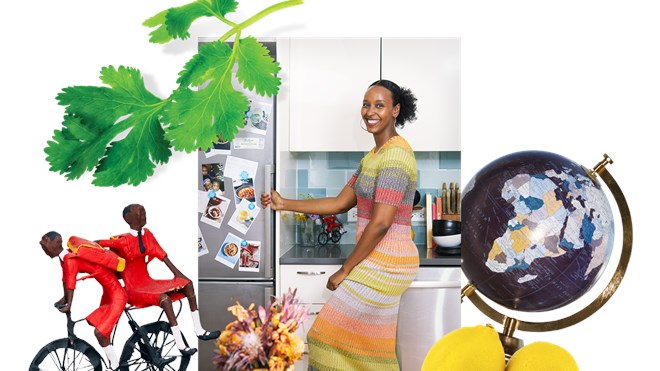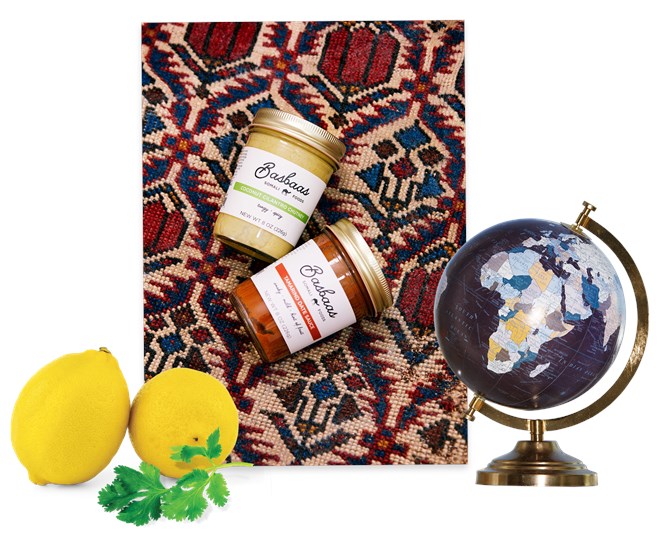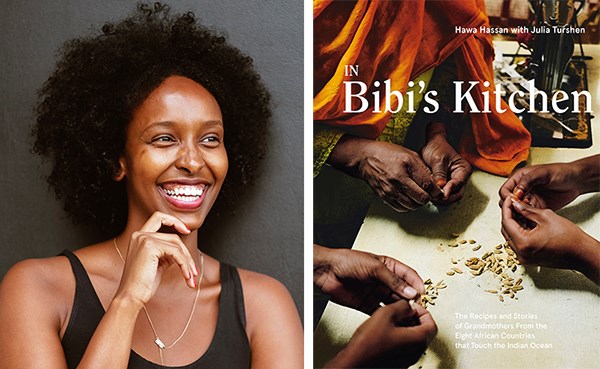
BY LAURA REGENSDORF
Thursday October 15, 2020

The Somalia native behind the condiment line Basbaas talks about her new cookbook and gives Vanity Fair a tour of her Brooklyn kitchen.
“For me, when I have such joy, and where I pull a lot of my strength, is just being in kitchens with women—commotion and stillness at the same time,” says Hawa Hassan, speaking by phone from her studio apartment in Brooklyn. It’s just past noon on a recent Saturday, and her kitchen is momentarily still: coffee not yet drunk, delivery on the way. But the picture she paints is a vibrant one, full of chatter and smells and pots bubbling with the pasta sauce suugo suqaar. Hassan, a Somali native, founded her condiment line, Basbaas, in 2014 on the basis of such memories, drawing inspiration from her mother’s recipes. This week—with the publication of In Bibi’s Kitchen, a new cookbook written with Julia Turshen—Hassan broadens the scope to eight African countries along the Indian Ocean.
Hassan’s own story could fill a book—childhood in Mogadishu, a year in a U.N. refugee camp in Kenya, followed by a solo voyage to Seattle at age seven—but it’s matriarchs who take the spotlight in this ode to home cooking. Structured as a series of grandmotherly house calls, the book is the antithesis of star chef braggadocio; it’s also a counterpoint to a food-media landscape lately criticized for overlooking such perspectives. Plainspoken interviews sit alongside domestic scenes photographed by Nairobi-based Khadija Farah. We meet an elegant Ma Gehennet in Yonkers, New York, as she makes an Eritrean flatbread called kicha. In South Africa, Ma Khanyisa gives her recipe for imifino (wild greens with porridge). Wearing a yellow apron and brightly patterned head wrap, she talks about a spirit of resilience. “There’s a term called zenzele, and it means ‘do it yourself,’” the woman explains. “But even when you do the zenzele thing, you do it in a community. People support you. If you have a piece of land, people will come, and you will plow together, you harvest together.”
That kind of wisdom—threaded between plantain stews and primers on East African colonialism (hence the prevalence of Italian-style red sauce in Somalia)—makes the book feel especially well-timed in a moment all about home cooking and community. Early in the pandemic as people retreated indoors, Hassan joined efforts to deliver food to overburdened hospitals. Later on in the summer, she nailed down a new production facility for Basbaas. The original two condiments, a coconut-cilantro chutney and a tamarind-date sauce, are soon to be joined by four more—one based on a suugo recipe in the book, which will have pasta fans rejoicing come winter. In the conversation below, Hassan talks up weeknight meals, recalls her rebellious palate as an immigrant teen, and tells us about the smiling spoons in her kitchen sink.
Vanity Fair: When did the idea for a cookbook come about? Was it already in mind when you launched the condiments back in 2014?
Hawa Hassan: I was very strategic in terms of producing condiments first off. I really wanted to have a healthy conversation about my origins, and I wanted to introduce people to the cuisine of the continent of Africa. If I can get to their table, then they'll be interested in the larger picture. For me, the larger picture then became the stories about where I come from—and what better way to do that than through grandmothers and recipes of just one country, but eight countries.
I spent a great deal of my childhood being at the feet of my mom and my grandmother. So I just kept looking at photos and videos [in the food media] and I didn't see these women getting the camera time in the way that men were. I thought, “O.K., what about a book that focuses on the matriarchy?”

Clockwise from top: Hassan’s original Basbaas sauces; four more will join this fall. The globe is a reminder that “at my desk, the world is possible,” she says. Two ingredients in the line’s Coconut Cilantro Chutney.PHOTOGRAPHS BY KYOKO HAMADA. LEMONS AND CILANTRO: FROM GETTY IMAGES.
The food narrative is so often about a star chef or celebrity, and this book feels decentralized in a nice way—from the bibis to your book collaborators. What were your considerations there?
I believe, as I rise, it’s my responsibility to make sure that my community also rises with me. So when I went to Ten Speed and said, “I’m going to be using this not-well-known photographer in this industry on this big project,” I think originally there was some hesitation, but very quickly everybody was on board with Khadija Farah, who’s based in Nairobi, who’s also Somali, who’s hijabi. All these things for me were really important because I want my community to be visible in the work that I do. I never want to be the only person at the table who looks like me. And when Khadija was brought onto this project, she was made well aware of that: “When this book comes out, you’re going to get opportunities that you maybe otherwise wouldn't have seen.” My hope is that she then extends the offer to someone else who looks like us, or comes from where we come from.
I imagine a female photographer also made these women feel at ease.
Yeah, and Khadija speaks Italian, French, Somali, English, Swahili, Arabic. All of that was very strategic, too, because these grandmothers speak many languages and English is not their thing.
Your original Basbaas condiments are based on your mother’s recipes. What is her influence on the book?

Hawa Hassan and photo credit:Khadija M. Farah
My mom is a beautiful storyteller, and she's the backbone of her community. She lives in Norway now, and wherever she has gone in the world, she has built a solid group of people to call family and friends. I think that it comes out in this book. Not only was my mom my inspiration for creating the condiments and hoping to change the rhetoric about where we come from, but she’s so similar to these women—because she herself has had to leave and start over. She herself had to survive civil unrest. She herself has gone through divorce. A lot of women share those kinds of stories in this book, about not what’s “new and next” but what is next for a generation? With my mom, their stories are her stories. All the bibis are so intertwined with one another because their lived experiences are very similar.You were sponsored by a family at age seven and moved to Seattle. How did that affect your palate and what you were eating?
I still very much went out into the world and I would eat banana and pizza together, and my friends were, like, “What are you doing?” Because it’s what I knew, and I was longing for that savory and sweet taste together. The smell of cinnamon can literally transport me to my mother; the smell of incense burning. So there was always a longing. I spent a great deal of my childhood just eating red sauce and pasta because they reminded me of home. But then there was a rebellious stage where I was, like, “I reject all things Somali because these people who were supposed to take care of me never came.” So I was eating food that wasn’t halal—I mean, I still eat food that’s not halal—but I was eating pork. I was eating very much like the people I was around.
The book eloquently talks about various kinds of connection: wireless connection, family connection, cultures abutting one another. How has food been a point of connection for you in these months of isolation?
For me—I think because so much of my life is so rooted in community—in the beginning of the pandemic I was feeding hospitals. My business and I partnered with Colonia Verde, which is a restaurant in my neighborhood, and we fed Brooklyn Hospital, SUNY Downstate, and Kings Hospital along with a nonprofit called Brotherhood-Sister Sol. They partner with the greenmarket, but we’re a small part of their production, which we’re really lucky to be a part of.
I’m very much alone in this country in terms of family, so wherever I go, I make sure I plant myself, and I’m able to water myself by the group of people that I’m around. So it was really important not to sit at home, worried about who was going to get hurt. Immediately, I thought, “How are people going to eat?” That’s one thing I’m really proud of in this pandemic—that I really was able to highlight my community and I was able to get so much support from them. And we were able to expand our community because now we’re so close to so many doctors. I’d never gone to Harlem as much as I have during this pandemic, because of the nonprofit.
So there’s that aspect, which has been work and a lot of logistics, and then I do a lot of cooking for my partner. That’s been so nourishing, to be with someone who enjoys your food and who’s able to sit down with you at the end of the night, and just to look at one another and have very clear conversations about our days. He himself was feeding Woodhull Hospital. The world was falling apart, but we were meeting new people and having meaningful conversations and then we were kind of unpacking that together at the end of the night.
Speaking of weeknight meals, that category has become a gimmicky way to sell cookbooks: easy this, easy that. But it's nice in your book when the bibis explain why they chose a certain recipe: They say, “I make it every day.”
Yeah. I make shiro all the time, which is the chickpea recipe from Ethiopia. My best friend is Ethiopian, my godkids are Ethiopian, and I spent a lot of my childhood consuming Ethiopian food. So that’s something that I really enjoy cooking. What we’re trying to get people to understand is that this book is your everyday pantry. We talk about [the spice blend] berbere in there, which is so easy to buy now. I make a big batch of chickpeas, red onion, and carrots, and I basically make this awaze sauce that we’re going to produce soon, which is just berbere and red wine with honey. I put it all over my vegetables, then I roast them, and I keep it for the whole week. I repurpose it: I put an egg on it; I put up avocado on it; I put anchovies on it. The intention is to get people to understand that even if you’re not going to make a doro wat, which is the Ethiopian stew with the chicken drums, you can still use all of those spices and create something really fun and light and quick. Not that the doro wat isn’t fast and quick! I can make the doro wat in under 30 minutes. It’s getting people away from the idea that something is difficult just because they’re not familiar with it.